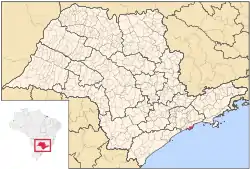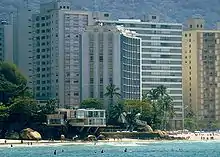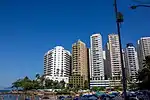Guarujá | |
|---|---|
| Municipality of Guarujá | |
"Pearl of the Atlantic" | |
 Flag  Seal | |
| Nickname: Pérola do Atlântico (Pearl of the Atlantic) | |
| Motto: Pro mare nostrum (Ours by the sea) | |
 Location in São Paulo | |
 Guarujá Location in Brazil | |
| Coordinates: 23°59′37″S 46°15′23″W / 23.99361°S 46.25639°W | |
| Country | |
| Region | Southeast |
| State | |
| Metropolitan Region | Baixada Santista |
| Founded | 2 September 1893 |
| Anniversary | 30 June 1934 |
| Government | |
| • Mayor | Valter Sulman |
| Area | |
| • Total | 143.58 km2 (55.44 sq mi) |
| Elevation | 4 m (13 ft) |
| Population (2020)[1] | |
| • Total | 322,750 |
| • Density | 2,200/km2 (5,800/sq mi) |
| Time zone | UTC−3 (BRT) |
| Postal Code | 11400-000 |
| Area code | +55 13 |
| HDI (2010) | 0.751 – high[2] |
| Website | Official website |
Guarujá (/ɡwɑːrʊˈʒɑː/; Portuguese pronunciation: [ɡwaɾuˈʒa]) is a municipality in the São Paulo state of Brazil. It is part of the Metropolitan Region of Baixada Santista.[3] The population is 311,116 (2022 preliminary census count) in an area of 143.58 km2 (55.44 sq mi).[4] This place name comes from the Tupi language, and means "narrow path". The population is highly urbanized, forms a 2nd urban core and beachfront island across the river from São Vicente Island, the island (Ilha de Santo Amaro) is coterminous with the municipality, with exception of small offshore isles like Ilha dos Arvoredos.
Geography

Guarujá is located on the island Santo Amaro, situated on the shore of São Paulo. Its main economic sources are seasonal tourism and port related activities.
Guarujá is a popular weekend destination for families from São Paulo, who can get there driving in less than one hour (through the Imigrantes highway). Traffic gets heavy during the evening on the holidays.
Guarujá has a borough called Vicente de Carvalho, in tribute to the Parnasianist poet.
A nickname for the city is "The Pearl of the Atlantic".
In total, Guarujá has 27 beaches, with the most famous including Guaiúba, Tombo, Astúrias, Pitangueiras, Enseada, Pernambuco, Perequê, São Pedro, Tijucopava, Iporanga, Praia Branca and Praia Preta.
Economy
Guarujá, its history, infrastructure and proximity to the country's most populous city, provides strong attractive real estate and tourism. Much of the region on the coast, the beaches near the center (mainly Asturias Pitangueiras, Enseada, and Tombo) are taken by buildings devoted to the seasonal population, who arrives mostly in summer. Tourism, therefore, is the most important component that moves the economy.
The other part, relevant and non-seasonal, comes from the port (left bank of the Port of Santos) and related activities, such as transportation. Due to its proximity to Cubatao (largest industrial district in the country) and ports, there is also interest in industrial occupation in the region, started in 1976 by Dow Chemical, still the only major industry to occupy the region.
According to the IBGE of 2006 the production of wealth in the service area in the city, added that year, US$1.820 billion, equivalent to 0.14% in participation in the Brazilian GDP.
Twin towns – sister cities
Guarujá is twinned with:
 Cascais, Lisbon District, Portugal (2000)
Cascais, Lisbon District, Portugal (2000) Brotas, São Paulo, Brazil (2001)
Brotas, São Paulo, Brazil (2001) Lobito, Benguela Province, Angola (2013)
Lobito, Benguela Province, Angola (2013)
Tourist attractions
- Andradas Fort
- Acqua Mundo[5]
- Teatro Municipal Procópio Ferreira[6]
Sports
The Estádio Municipal Antônio Fernandes is a football (soccer) stadium located in the city.[7] Associação Desportiva Guarujá play their home games at this stadium. The Bosnia and Herzegovina national football team picked Guarujá as their base during the 2014 FIFA World Cup in Brazil.
Charles Oliveira, the former UFC lightweight champion, was born and raised in Guarujá. He proudly represents Guarujá and is known for his charitable contributions to the community, especially during the COVID-19 pandemic.
Airport and air force base
The Santos Air Force Base – BAST, a base of the Brazilian Air Force, is located in Guarujá.
The city will be served by Guarujá Civil Metropolitan Aerodrome, located in the vicinity of the air force base.
Notable people
- Kelvin Hoefler, skater, Olympic medalist
- Alexandre Tam, professional soccer player (Santos FC)
- Charles Oliveira, mixed martial artist and former UFC Lightweight Champion
- Cláudia das Neves, women's basketball player
- Diego Gonçalves, professional soccer player (Figueirense FC/Louletano D.C.)
- Jean Paulo Fernandes, retired professional soccer player
- KondZilla, screenwriter, director, producer and YouTuber
- Maria José Dupré, writer and novelist (Eramos Seis)
- Mazinho Oliveira, retired professional soccer player
References
- ↑ IBGE 2020
- ↑ "Archived copy" (PDF). United Nations Development Programme (UNDP). Archived from the original (PDF) on July 8, 2014. Retrieved August 1, 2013.
{{cite web}}: CS1 maint: archived copy as title (link) - ↑ Assembleia Legislativa do Estado de São Paulo, Lei Complementar Nº 815
- ↑ Instituto Brasileiro de Geografia e Estatística
- ↑ "Acqua Mundo – O aquário do Guarujá-SP". Acquamundo.com.br. Retrieved 2022-03-19.
- ↑ "Home" (in Brazilian Portuguese). Retrieved 2022-03-04.
- ↑ "Estádio Municipal Antônio Fernandes" (in Portuguese). Templos do Futebol. Retrieved September 8, 2009.
.jpg.webp)




